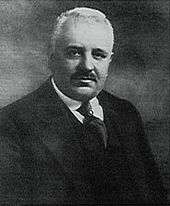Francesco Saverio Nitti
| Francesco Saverio Nitti | |
|---|---|
 | |
| 24th Prime Minister of Italy | |
|
In office 23 June 1919 – 15 June 1920 | |
| Monarch | Victor Emmanuel III |
| Preceded by | Vittorio Emanuele Orlando |
| Succeeded by | Giovanni Giolitti |
| Personal details | |
| Born |
July 19, 1868 Melfi, Italy |
| Died |
February 20, 1953 (aged 84) Rome, Italy |
| Political party |
Historical Extreme Left (1880s-1904) Radical Party (1904-1922) Liberal Democratic Party (1922-1926) Independent (1928-1953) |
| Religion | Roman Catholicism |
Francesco Saverio Vincenzo de Paola Nitti (19 July 1868 – 20 February 1953) was an Italian economist and political figure. A Radical, he served as Prime Minister of Italy between 1919 and 1920.
According to the Catholic Encyclopedia ("Theories of Overpopulation"), Nitti (Population and the Social System, 1894) was a staunch critic of English economist Thomas Robert Malthus and his Principle of Population. He was an important meridionalist and studied about the reasons of the problems that were born in South Italy after the Italian unification.[1][2][3]
Life
Born at Melfi, Basilicata, Francesco Nitti studied law in Naples and was subsequently active as journalist. He was correspondent for the Gazzetta piemontese ("Piedmontese Gazzette") and was one of the editors of the Corriere di Napoli ("Courier of Naples"). In 1891 he wrote the work Il socialismo cattolico ("The Catholic-socialism"). In 1898, when only 30 years old, he became professor of finance at the University of Naples.
Nitti was chosen in 1904 for the Radical Party to serve in the Italian parliament. From 1911 to 1914 he was minister of agriculture, industry and trade under prime minister Giovanni Giolitti. In 1917 he became minister of finance under Orlando; this latter post he held till 1919.
On 23 June 1919 Nitti became prime minister and interior minister. A year later he added to these roles the job of minister of the colonies. His cabinet had to deal with great social unrest and dissatisfaction over the results of the Treaty of Versailles. Particularly troublesome was the agitation over Fiume led by Gabriele D'Annunzio. Nitti had great difficulty keeping the administration functioning at all, thanks to the enmity between the extremely divergent political factions: the communists, anarchists and fascists. After less than a year as head of government, he resigned, and was succeeded by the veteran Giolitti on 16 June 1920.
In social policy, Nitti’s government passed a law setting up compulsory insurance for unemployment, invalidity, and old age.[4]
Still a member of the Italian parliament, Nitti offered resistance to the nascent power of fascism, and openly despised Benito Mussolini. In his 1927 book entitled "Bolshevism, Fascism and Democracy", he correlated Italian Fascism with communism, writing: “There is little difference between the two, and in certain respects, Fascism and Bolshevism are the same.” [5] In 1924 Nitti decided to emigrate, but after the Second World War he returned to Italy. He was elected to the Senate, first for the Italian Liberal Party in National Bloc and late for the Independent Left. As a secular and anti-clerical, was an opposer of Christian Democracy. To Italy's NATO membership he remained staunchly opposed.
In Rome on 20 February 1953, Nitti died. Throughout his career he deplored any kind of dictatorship, whether it was communist or fascist.
Notable works
- Population and the social system (1894)
- Catholic socialism (1895)
- Eroi e briganti (Heroes and brigands) - (edition 1899 – Osanna Edizioni 2015 - ISBN 8881674696, 9788881674695)
- L'Italia all'alba del secolo XX (1901)
- Principi di scienza delle finanzie (1903)
- Peaceless Europe (1922)
- The decadence of Europe (1922)
- The wreck of Europe (1923)
References
- ↑ Francesco Saverio Nitti, L'Italia all'alba del secolo XX, Casa Editrice Nazionale Roux e Viarengo, Torino-Roma, 1901
- ↑ Francesco Saverio Nitti, Domenico De Masi, Napoli e la questione meridionale, Guida, Napoli, 2004
- ↑ La scienza della finanza 1903-1936
- ↑ Democracy and Social Policy by Yusuf Bangura
- ↑ Francesco Saverio Nitti (1927), Bolshevism, Fascism and Democracy, New York: NY: Macmillan Co., p. 130
External links
- Works by Francesco Saverio Nitti at Project Gutenberg
- Works by or about Francesco Saverio Nitti at Internet Archive
| Political offices | ||
|---|---|---|
| Preceded by Vittorio Emanuele Orlando |
Prime Minister of Italy 1919–1920 |
Succeeded by Giovanni Giolitti |
| Italian Minister of the Interior 1919–1920 | ||
.svg.png)
